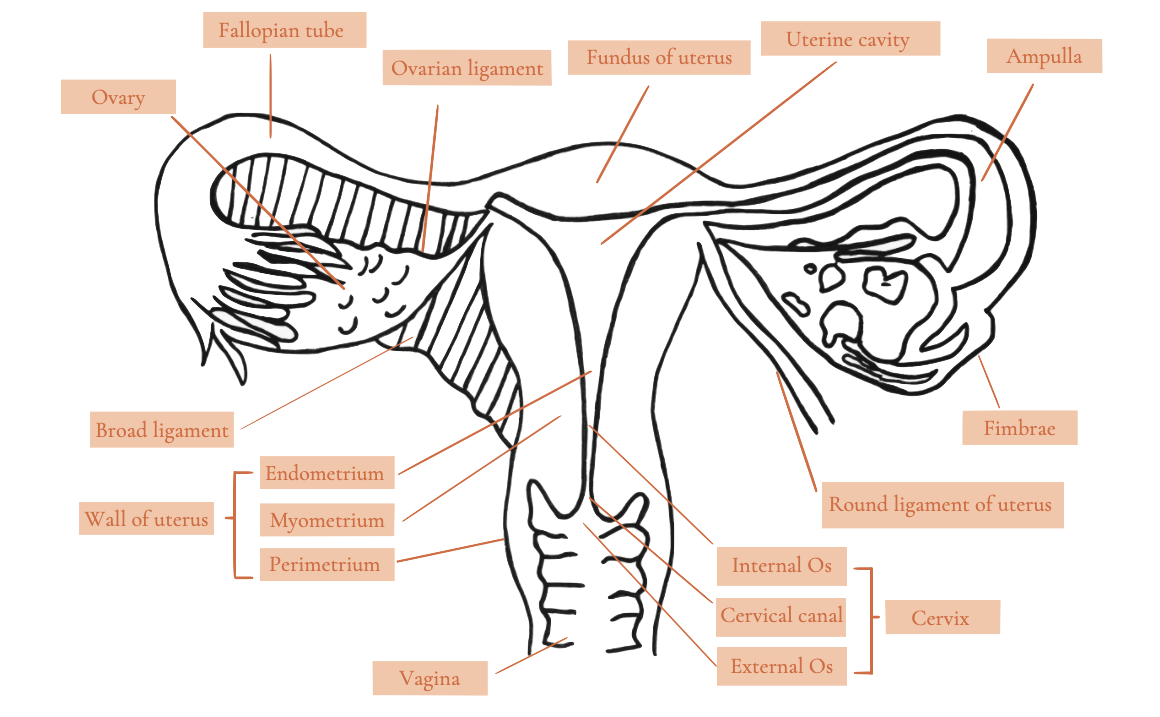female reproductive anatomy
I'm sure you are familiar with the basics of your lady parts but how well do you really know your own body? Do you understand why did does the things that it does? Or why you feel a certain way at around the same time each month?
Getting to understand your body inside and out can support your menstrual cycles, sexual health and general wellbeing. It will help you to recognise when something isn’t right and can help you to feel more comfortable in your own skin. We are going to be discussing the female reproductive system throughout the next couple months so we thought it would be a great idea to start with the basics; the anatomy.
the vulva
The external genital anatomy is what can be seen on the outside of the body. Collectively this is referred to as the vulva.
This is a great opportunity for you to grab a mirror and get a little more familiar with yourself.
Clitoris - or head of the clitoris - a nerve-rich area of the vulva that's key role is sexual pleasure (oh yes!). The area indicated in the diagram is just where the head of the clitoris is visible from the outside, the internal area of the clitoris is much larger.
Labia majora - the folds of hair covered skin located behind the mons pubis.
Labia minora - thin, pigmented flaps of skin located in the middle of the labia majora.
Side note: the labia majora and labia minora names are no indication as to what size these are compared to the other. As it is just as common for the minora to be larger in size compared to the majora.
Perineum - area between the anus and vulva
Mons pubis - located at the front of the vulva is a mound of fatty tissue beneath pubic hair that protects the internal genital organs.
Urinary opening - the opening from which urine is expelled.
Vaginal opening - an opening that leads into the internal reproductive anatomy. This opening is where the penis (or sex toys) is inserted during sexual intercourse, where menstrual blood is expelled from the body and the opening from which a baby is delivered during labour.
Hood of clitoris - a fold of skin that surrounds the head of the clitoris. Protects the sensitive nerve endings of the clitoris.
internal
The internal genital organs. This is on the inside of the body.
Uterus - aka the baby-maker, the most magical part of the human body. This muscular organ can stretch many times its original size to accommodate a developing foetus. The myometrium, the muscular portion of the uterus contracts during childbirth and menstruation.
Fallopian tubes - the fallopian tubes are muscular and lined with microscopic hairs known as cilia, which line the entire length of each fallopian tube. The cilia move in a continual motion that push the ovum (the egg) in the direction of the uterus.
Ovary - this is where the eggs live. The ovaries are situated bilaterally, at the end of each fallopian tube. The ovaries are not attached to the end of the fallopian tube, but to the uterus, by the ovarian ligament. The ovaries are also responsible for producing the hormones oestrogen and progesterone.
Endometrium - the endometrium is the inner lining of the uterus. It is made up of two layers of tissue that merge and appear as one. All changes that occur during the menstrual cycle are designed to prepare the endometrium to sustain a fertilised ovum. The innermost layer of the endometrium increases throughout the menstrual cycle and then if an egg is not fertilised it sheds as a period bleed. This process repeats every 28-35 days.
Vagina - situated between the rectum and the urethra, this muscular canal is approximately 10cm in length and connects the external anatomy to the internal anatomy. Cervical discharge/fluid and menstrual blood travel through this canal to exit the body.
Cervix - commonly referred to as ‘the gateway to the uterus’. The lower third of the uterus is the tubular cervix, about half of which protrudes down into the vagina. The other half of the cervix is above the vaginal attachment. The cervix can produce fluid which can facilitate the movement of sperm to travel ready for fertilisation.
There you have it, your crash course on the female anatomy. There is a lot to learn about all the things a woman’s body can do but taking the time to get to know and understand your body will help you become more comfortable with it and more away of what feels right and wrong. There is no reason to be embarrassed by your body, embrace it and learn from it.



